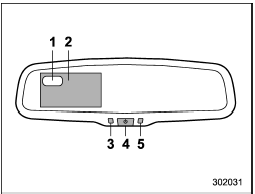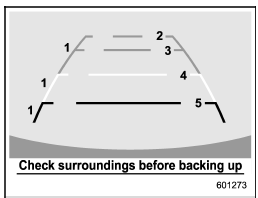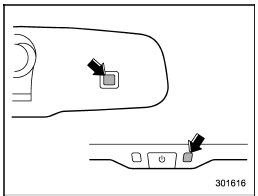Type B inside mirror (if equipped)

1) Electronic compass display
2) Rear view image display
3) Auto dimming indicator
4) Multifunction button
5) Photosensor
The mirror has the following features.
• Rear view image display
• Auto-dimming function for anti-glare
capability
• Electronic compass display
You can display the various functions of these features based on how long you press the multifunction button.

▲ Rear view image display
When the ignition switch is “ON” and the select lever is set to “R”, the rear view camera automatically displays the rear view image behind the vehicle on the inside mirror.
Also, the following help lines are indicated as a guide to help you realize the actual distance from the display.

1) Vehicle width line (oblique vertical line)
2) Approx. 10 feet (3 m) from the bumper
(green horizontal line)
3) Approx. 6.5 feet (2 m) from the bumper
(green horizontal line)
4) Approx. 3 feet (1 m) from the bumper
(yellow horizontal line)
5) Approx. 1.5 feet (0.5 m) from the bumper
(red horizontal line)
These help lines are removable. To remove the help lines, perform the following procedure.
1. Display the rear view image on the mirror.
2. Press the multifunction button for more than 3 seconds to remove the help lines.
To display the help lines, press the multifunction button for more than 3 seconds.
For precautions about the rear view camera and the rear view image, refer to “Rear view camera”.
▲ Auto-dimming function
The auto-dimming function is an anti-glare capability which automatically reduces glare coming from headlights of vehicles behind you.
By briefly pressing the multifunction button, the auto-dimming function is toggled on or off. When the auto-dimming function is on, the auto dimming indicator light (green) will illuminate.
Even with the mirror in anti-glare mode, the mirror surface turns bright if the transmission is shifted into reverse. This is to ensure good rearward visibility during reversing.

The mirror has a photosensor attached on both the front and back sides. Use care not to cover the sensors with stickers, or other similar items. Periodically wipe the sensors clean using a piece of dry soft cotton cloth or an applicator.
NOTE
When cleaning the mirror, use a paper towel or similar item dampened with glass cleaner. Do not spray glass cleaner directly on the mirror surface.
By doing so, the sprayed glass cleaner could enter the inside of the mirror housing. That may cause a malfunction in the mirror.
▲ Electronic compass display
By pressing the multifunction button for 3 to 6 seconds, the compass display is toggled on or off. When the compass display is on, an illuminated compass reading will appear on the mirror.
Using the electronic compass properly, the following compass zone adjustment and compass calibration will be necessary.
▲ Compass zone adjustment
1. The compass zone has been set to zone “8” at the time of shipment from the factory. Refer to the “Compass calibration zones” map, which is attached to the end of this manual to verify that the compass zone setting is correct for your geographical location.
2. Press and hold the multifunction button for 6 to 9 seconds, and then release it.
The zone number will be displayed.
3. Press the multifunction button repeatedly to cycle the display through all possible zone settings. Stop cycling when the correct zone number for your location is displayed.
4. Releasing the button for 3 seconds will exit the zone setting mode.
▲ Compass calibration
1. For optimum calibration, switch off all nonessential electrical accessories (rear window defogger, heater/air conditioning system, spotlight, etc.) and ensure all doors are shut.
2. Drive to an open, level area away from large metallic objects or structures and make certain the ignition switch is in the “ON” position.
3. Press and hold the multifunction button for 9 to 12 seconds, and then release it. The compass will enter the calibration mode, then “C” and the direction will be displayed.
4. Drive slowly in a circle until “C” disappears from the display. Driving in two or three circles might be necessary.
The compass is now calibrated.
5. Further calibration may be necessary should outside influences cause the compass to read inaccurately. You will notice any outside influence if the compass tends to read in only one particular direction.
Should you encounter this situation, return to step 1 of the above procedure and recalibrate the compass.
